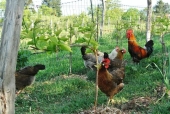posted 5 years ago
I respect your stubbornness, but also think S. Lowe (just got the name pun!) has a good point as well. It seems similar to the veganic gardening ideal, which is commendable in many ways, but rigid adherence to its extreme breaks down logically when considering how integral animal life is to healthy soil and ecosystems. Similarly, good and bad stuff floats onto our properties on the wind and in bird droppings, and if we cannot think of how to benefit from that then we are missing an opportunity.
For my property and food forest sites I develop/manage, I generally consider the cost-benefit of my transporting materials for the destination, the point of origin, and to the Earth as a whole (i.e. fossil fuel use). Does my taking woody debris from arborists and homeowners benefit my site as I use it for hugels, riparian restoration and mulch? Does it benefit the site where it came from due to wildfire risk management? Would it simply get wasted and turned to smoke pollution in a burn pile or get wastefully transported many miles to our closest municipal compost facility? I also consider how pristine or degraded the the site I am working on is, and its place in the watershed. I ask my woody debris and manure sources about their practices and try to gauge the risk of potential contamination, but I am also realistic about how not everyone will be honest or informed in their answers, especially if they have motivation to unload it. For that reason, I am far pickier where I am working at the top of the watershed, at the edge of wilderness, than I am in an already and inevitably continually polluted lower basin in an urban area. Of course I won't just say f'-it and throw poison on the latter site, but I think it makes sense to try to balance risk-benefit and consider everything in context with the intent of making things better for everybody, all-around. The woody debris I use in bio-remediating, slowing, spreading and sinking contaminated water running off pavement upstream does not necessarily warrant the pickiness I may have in building a hugel bed for a kitchen garden.
On the pH/lime note, I'd encourage looking into the recent soil research by Elaine Ingham and others (Matt Powers has a lot of podcasts and writing on this). It seems like regardless of the pH of the soil, in the vast majority of cases the pH at the root interface (especially in perennial plants and trees) is surprisingly low (3-4), as this is the preferred acidity for facultative fungi. Also, where I am in coastal CA, soils commonly have a calcium deficiency but a Magnesium excess, and my understanding this is common in other wet marine influence climates/geology. So here it is not advisable to lime, as this will exacerbate the magnesium excess (to a toxic extent on one site I have worked on), which I understand to ironically lead to Calcium lockout. Therefore, I use oyster shell, which is high in Ca but has no Magnesium, and its texture can also help with soil structure and aeration. This may be one benefit of a soil test, but like you I mostly just read the weeds now.
This is all just my opinion based on a flawed memory

 1
1





 3
3




 1
1












 4
4














 1
1




 3
3




 . I'll echo Chris' comments about being wary of bringing onsite organic matters like manures and composts as there is no real good way to know what's in them, and the risks can be high.
. I'll echo Chris' comments about being wary of bringing onsite organic matters like manures and composts as there is no real good way to know what's in them, and the risks can be high.
 2
2


















